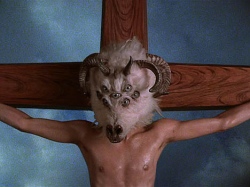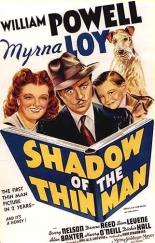
 Four movies in, most series start to show signs of wear and tear, and the Thin Man series was no exception. It’s only partly the fault of Nick and Nora’s kid. He was all right in After the Thin Man, but he poses a bit of a problem in Shadow, as love and chemistry have been replaced with precociousness. That can be annoying, but fortunately, Nick Jr. doesn’t have a lot of screen time. Yay again for nannies! (On the other hand, boo for racially stereotypical ones: “Yas’m, Mrs. Charles! Mr. Charles knew you was makin’ that drink! He must have telegraphy!”)
Four movies in, most series start to show signs of wear and tear, and the Thin Man series was no exception. It’s only partly the fault of Nick and Nora’s kid. He was all right in After the Thin Man, but he poses a bit of a problem in Shadow, as love and chemistry have been replaced with precociousness. That can be annoying, but fortunately, Nick Jr. doesn’t have a lot of screen time. Yay again for nannies! (On the other hand, boo for racially stereotypical ones: “Yas’m, Mrs. Charles! Mr. Charles knew you was makin’ that drink! He must have telegraphy!”)
On the other other hand, Junior does provide one of Shadow’s best bits when he refuses to drink his milk unless Daddy drinks some, too. That horrifies Nick Sr., who’s already on his 12th martini of the day. It’s funny, but it also brings up the real problem with having the tot around. Nick’s alcoholism was amusing before he had a son, but it’s frickin’ uncomfortable to watch him take the boy on a merry-go-round while needing to lean against a horse just to stand upright.
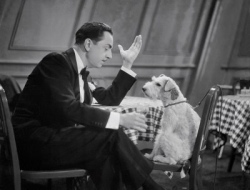 The mystery’s not particularly inspired, either. It has to do with organized crime and betting on sporting events. I yawned just typing that. Nick gets involved because a buddy of his is the prime suspect when someone turns up dead. Barry Nelson, the original James Bond, plays the friend, so that’s cool. And a very young Donna Reed plays Barry’s girlfriend.
The mystery’s not particularly inspired, either. It has to do with organized crime and betting on sporting events. I yawned just typing that. Nick gets involved because a buddy of his is the prime suspect when someone turns up dead. Barry Nelson, the original James Bond, plays the friend, so that’s cool. And a very young Donna Reed plays Barry’s girlfriend.
Although things are starting to look tired, there are still plenty of laughs to be had. As usual, Nora gets in some great lines and even pitches in on the detective work more than she has before. There’s obviously still life in the series, but — like Nick’s drink — it needs some freshening. With two films left in the franchise, I hope it got some. —Michael May


 If you should see
If you should see  We’re to believe, of course, that Chuck Norris could defeat Jack O’Halloran, but c’mon! We’ve all seen
We’re to believe, of course, that Chuck Norris could defeat Jack O’Halloran, but c’mon! We’ve all seen 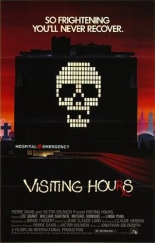
 I am not a fan of hospitals. I can’t take three steps into one without being overcome with a wave of anxious nausea, keenly aware that somewhere in that building — far closer than I’d like — someone is drawing his or her last breath. Ironically, it’s that same anxiety that draws me to hospital-set and medical-themed horror movies, since they allow me to face my fear without risk or consequence. Having seen a lot of them, I can comfortably say that the 1982 Canadian-made
I am not a fan of hospitals. I can’t take three steps into one without being overcome with a wave of anxious nausea, keenly aware that somewhere in that building — far closer than I’d like — someone is drawing his or her last breath. Ironically, it’s that same anxiety that draws me to hospital-set and medical-themed horror movies, since they allow me to face my fear without risk or consequence. Having seen a lot of them, I can comfortably say that the 1982 Canadian-made  The film stars Michael Ironside as a misogynist maniac on a mission to kill the popular female broadcaster (Lee Grant) who has taken on the cause of a battered woman unjustly convicted of murdering her abusive husband. When his initial attack on her is thwarted, he returns to the hospital to finish the job, but only manages to kill a bunch of other people before she is able to use his own knife to end his deadly spree.
The film stars Michael Ironside as a misogynist maniac on a mission to kill the popular female broadcaster (Lee Grant) who has taken on the cause of a battered woman unjustly convicted of murdering her abusive husband. When his initial attack on her is thwarted, he returns to the hospital to finish the job, but only manages to kill a bunch of other people before she is able to use his own knife to end his deadly spree.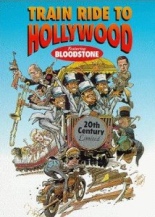
 In the realm of bad musicals, most know about
In the realm of bad musicals, most know about 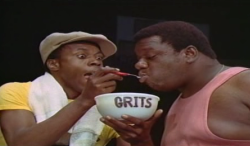 Said choo-choo is headed to Tinseltown, and the passengers are impersonations of movie legends Humphrey Bogart, W.C. Fields, Dracula and Clark Gable, who uses the “Frankly, my dear, I don’t give a damn” joke more than once. Also aboard are a sheik with seven whores,
Said choo-choo is headed to Tinseltown, and the passengers are impersonations of movie legends Humphrey Bogart, W.C. Fields, Dracula and Clark Gable, who uses the “Frankly, my dear, I don’t give a damn” joke more than once. Also aboard are a sheik with seven whores, 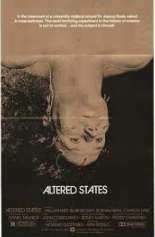
 There’s no need to watch
There’s no need to watch 